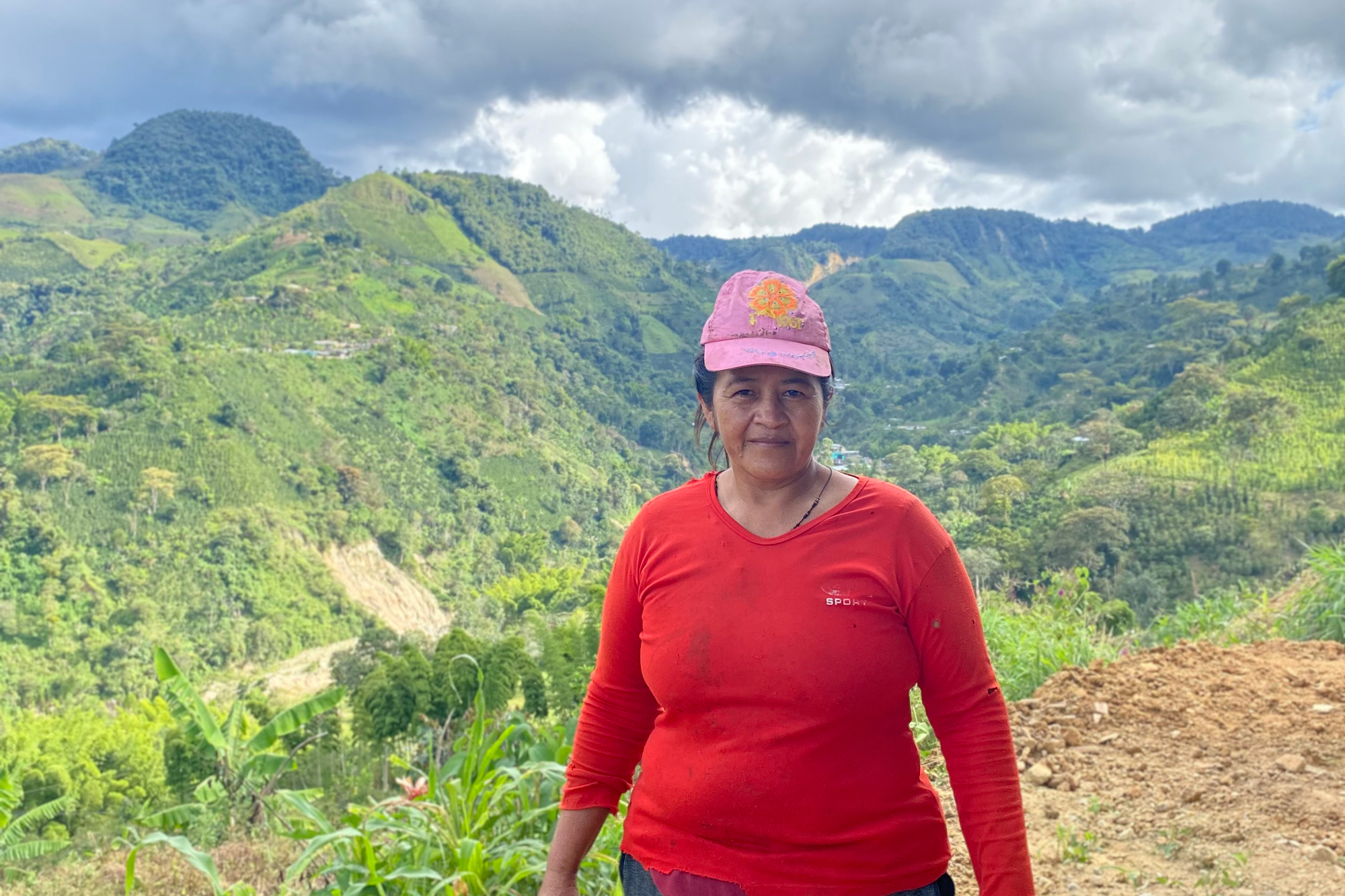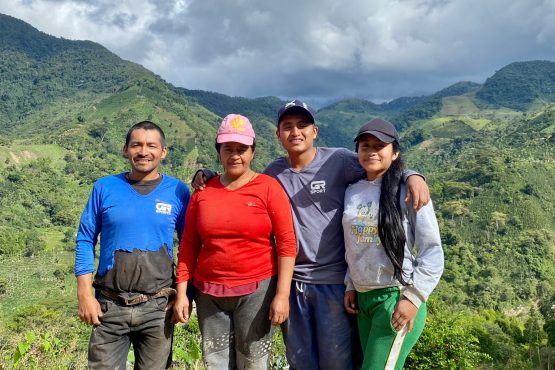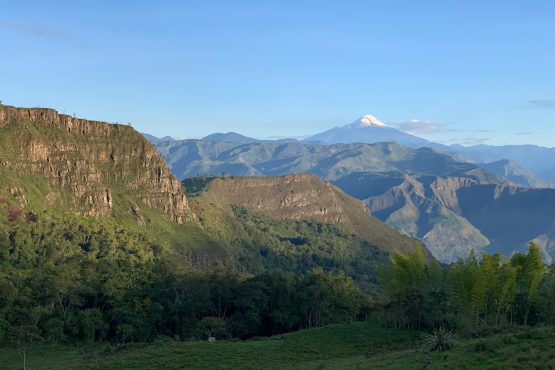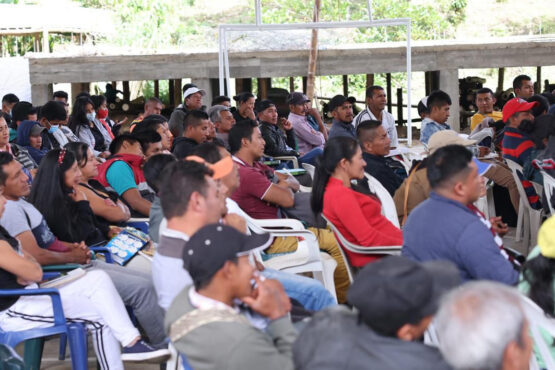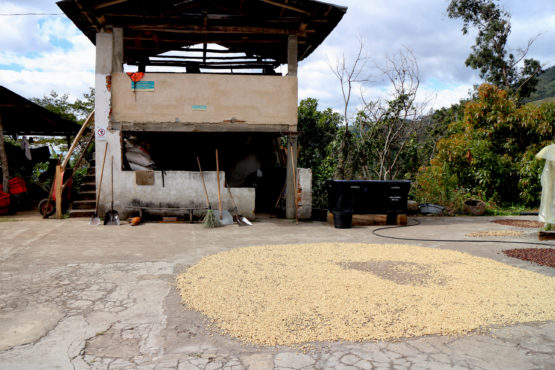Los Naranjos
Pear, apricot and vanilla, with a creamy body and almond nougat on the finish. Intensely sweet, with lingering white blossom florals.
This coffee was produced by Isaura Cuchumbe on her small farm, Los Naranjos, located near the town of Alto Palmar, in the municipality of Páez in the state of Cauca, in Colombia’s south.
At seven hectares in size, Los Naranjos (which translates to ‘the orange trees’ in Spanish) is a relatively large farm for the region, where plots average just one and a half hectares. The farm is situated across 1,600-1,900m above sea level, in the steep, rugged hills that surround Alto Palmar. Isaura lives on the property with her husband Neyid, who also farms coffee on a different plot, and their five children. They moved to Los Naranjos eleven years ago, after saving enough money to buy their own property. Together, Isaura and Neyid have been key members of Pergamino’s Allied Producer Program, and leaders in their community.
Los Naranjos is mainly planted with Colombia, a hybrid variety introduced by Colombia’s Coffee Federation (FNC) in the 1980s, in an effort to reduce the incidence of coffee leaf rust without affecting cup quality. The farm also has some San Bernardo variety trees (known as Pache in Guatemala), which produce coffee cherries that are very high in sweetness and have great potential for excellent cup quality when grown at high elevations. Isaura farms her coffee with traditional techniques, and intercrops her plantation with corn, beans, bananas and cassava. Fertilisation occurs around three times a year, usually after manual weeding, and pesticides are rarely used.
Like most of the nearby towns, Alto Palmar has breathtaking views of Colombia’s highest volcano, Nevado del Huila, which sits at the point where the states of Huila, Tolima and Cauca meet. The rich, volcanic soil of the area makes it ideal for agriculture and contributes to the excellent cup quality of coffees grown and processed here. Cool overnight temperatures result in dense beans, which are notable for their sweetness and complexity. Lower temperatures and high rainfall also influence processing techniques, with longer-than-usual ferment and drying times being necessary.
ABOUT PÁEZ, CAUCA
The municipality of Páez is located in the corner of the state of Cauca, close to the border with Huila and looking out to the west over the Pacific Ocean. Much like its neighbour Inzá, this region has excellent conditions for growing high-quality coffee, with high elevations and rich volcanic soil. The plateau has very stable climate year-round thanks to its proximity to the equator and the surrounding mountains, which protect the coffee against the humidity of the Pacific and the trade winds from the south. This region is an important source of water and wildlife, in addition to being prime coffee-growing land.
Páez is the traditional home of the Nasa (or Páez) people, one of Colombia’s largest indigenous groups. During the Spanish invasion of Colombia, many of the Nasa were able to avoid bloodshed by escaping to the rugged hills and high plateaus of the Andes Mountains, where the Spaniards were unable to pursue them. Today, the Nasa economy relies on agriculture, and society is organised into tight knit farming communities who distribute duties equitably under the guidance of cabildos, or locally elected councils. Like many indigenous groups across Latin America, the Nasa have spent decades lobbying for the return of their land rights, finding success in recent years. Their struggle has led to legal recognition of the fundamental rights of indigenous peoples, including recognition of the autonomy of their communal indigenous lands in the 1991 Colombian Constitution.
Isaura’s farm in Alto Palamar is located near the historically significant town of Belalcazar, one of the first regions to be recognised as communal land legally owned by the Nasa some 400 years ago.
Coffee from Cauca has historically been very difficult to access due to the region’s isolation and instability. For many years this part of Colombia was under the control of Colombia’s notorious rebel group, the FARC, and as a result, it was unsafe and violent. Since 2012, safe access to this region has been possible as a result of peace talks between the national government and the rebels. Thanks to these efforts, more and more stunning coffees from small producers in the region have become accessible to international buyers.
Our export partners for this coffee, Pergamino, have worked hard commercialise specialty-grade coffee throughout Cauca, and are now able to source some outstanding coffees from very dedicated producers. They work closely with the producers to give them feedback on their coffees (provided by Pergamino’s expert team of cuppers) and provide top up payments when the coffee is sold at a higher premium.
Head here to learn more about the work of Pergamino.
HOW THIS COFFEE WAS PROCESSED
The coffee in this lot was selectively hand-harvested, with most labour being provided by Isaura, Neyid and their family. It was processed using the washed method at the farm’s ‘micro-beneficio’ (mill).
The coffee was pulped using a small manual or electric pulper and then placed into a fermentation tank, where it was fermented without water for around 36 hours (depending on the weather and the farm’s location) and then washed using clean water from nearby rivers and streams.
The coffee was then carefully dried (over 10–18 days) on concrete patio. Rakes are used to turn the coffee regularly during the drying stage, to ensure even drying. Once dry, the coffee was delivered to Pergamino’s warehouse in Medellín, where it was cupped and graded. Once approved, coffee rested in parchment until it was ready for export.
